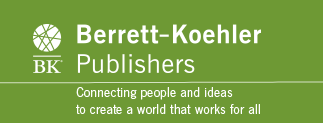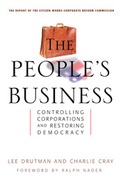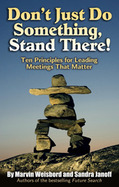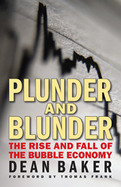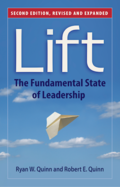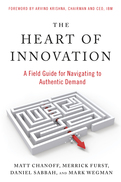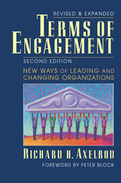More than ever, large corporations wield an unjustifiably excessive influence over our lives. The consequences are indeed frightening-environmental destruction, political corruption, erosion of democracy, increased polarization between rich and poor, declining wages and benefits, increased stress and overwork. As corporations become more powerful, these problems will only get worse.
The People's Business offers a comprehensive series of proposals for reforming and restructuring corporations so that they become the people's servants, not their masters. Writing in a lively populist style, the authors pull together recommendations from the prestigious members of the Citizen Works Commission on Corporate Reform to present a clear-headed plan of action.
Drutman and Cray discuss how corporations managed to achieve their current privileged position and offer a comprehensive approach for reconceiving corporations as engines of public prosperity, not private plunder. They outline specific reforms that could be enacted to get corporations out of politics, establish truly public-minded regulation of corporate behavior, safeguard our natural resources, combat unfair market domination by corporations, crack down on corporate crime, and challenge the corporate claim to constitutional rights.
Bolstered with relevant history and recent examples, The People's Business is a lively book that will appeal both to deeply-committed (and often frustrated) long-time activists looking for a coherent approach in the struggle for corporate accountability, as well as relative newcomers looking for immediate measures that could serve as effective means of corporate reform.
- The official report of a commission of 50 prominent leaders of the corporate reform movement that includes such notable members as Ralph Nader, David Korten, Herman Daly, Medea Benjamin, and many others
- Includes specific, detailed prescriptions for how we can take our country back from corporate rule and integrates them into a coherent strategy
- Written in an engaging, hard-hitting style with lots of concrete examples
- Presents often contrarian insights into how to design meetings that actually accomplish something
- Filled with case examples and exercises
- Draws on the authors' decades of experience working with businesses, nonprofits, and government agencies worldwide
2009
Dean Baker's Plunder and Blunder chronicles the growth and collapse of the stock and housing bubbles and explains how policy blunders and greed led to the catastrophic --but completely predictable --market meltdowns. An expert guide to recent economic history, Baker offers policy prescriptions to help prevent similar financial disasters.
Plunder and Blunder chronicles the growth and collapse of the stock and housing bubbles, explains how policy changes since 1980 laid the groundwork for catastrophicbut completely predictablemarket meltdowns, and offers prescriptions for avoiding these disasters in the future. Dean Baker argues not only that competent economists should have recognized the developing housing bubble, but also that policy makers and the media cheerfully neglected those economists who did predict danger. Baker doesnt engage in 20-20 hindsight, but thoroughly documents how fundamental policy shifts destabilized the economy and eroded the broad prosperity of the post-war period. His expert analysis explains the outcomes clearly so we can prevent similar financial disasters.
2015
Harness the Science of Positive Influence
Just as the Wright Brothers combined science and practice to finally realize the dream of flight, Ryan and Robert Quinn combine research and personal experience to demonstrate how to reach a psychological state that lifts us and those around us to greater heights of achievement, integrity, openness, and empathy. The updated edition of this award-winning book—honored by Utah State University's Huntsman School of Business, Benedictine University, and the LeadershipNow web site --includes two new chapters, one describing a learning process and social media platform the Quinns created to help people experience lift and the other sharing new insights into tapping into human potential.
Books on innovation mostly focus on how to nurture innovative cultures and brainstorm ideas. The Heart of Innovation is the first popular book to concretely delve into what innovations really are and how to create them. Many attempts at innovation fail because customers turn out to be indifferent. The key to success is to uncover unmet authentic demand; what customers cannot be indifferent to. Through fresh case studies, ranging from how SoulCycle revolutionized the fitness industry, to how IBM built an $8 billion business on the Web, to a single mother ending abuse in a slum in Africa, The Heart of Innovation explores how authentic demand is often hidden or taken for granted.
The first half of the book explores cases where people accidentally found their way to meeting an unmet authentic demand-or failed to. The second half of the book provides a field guide to methodically identifying and building products, services, and businesses around authentic demand.
At Georgia Tech, IBM, and elsewhere, the authors have worked with scores of startups and large companies, developing a unique methodology that unpacks the black box of authentic demand and shows innovators how to search for it, recognize it, and create situations for their customers that catalyze it. They explore the differences, and different challenges, to the three types of innovation-incremental improvement, company transformation, and radical formative innovation.
Authors Chanoff, Furst, Sabbah, and Wegman take innovators and people who work with them on a new journey through innovation. Their fresh case studies, from IBM's entry to the Web, to a single mother in a slum in Kenya, make The Heart of Innovation as obsessively readable as it is informative.
If customers are already pulling your innovation from your hands, you don't need this book. Otherwise, reach for The Heart of Innovation.
2010
Richard Axelrod offers a better way. After debunking six common change management myths, he offers a proven, practical strategy for getting everyone—not just select committees or working groups—enthusiastically committed to organizational transformation. This revised edition features new interviews—everyone from the vice president of global citizenship at Cirque du Soleil to a Best Buy clerk—and new neuroscience findings that support Axelrod's model. It also shows how you can foster engagement through everyday conversations, staff meetings, and work design.
